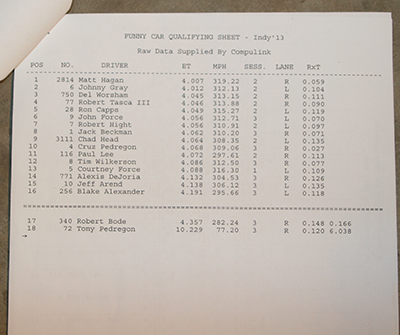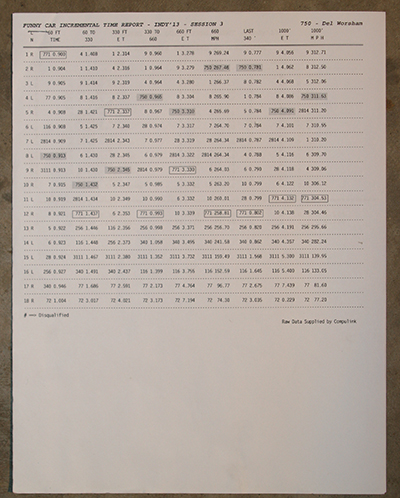 |
| This qualifying sheet is passed around to all the professional racers after every round. As you can see, on the left is the position where the driver is qualified, next is the car number, then the driver's name, their best qualifying ET, MPH for that run, which session they made that run in, which lane it was in and their reaction time on that run. |
DRO: I remember when I worked for Leonard Hughes in 1994 on the Smokin’ Joe’s Funny Car and the car was kind of lazy the first part of the track and then it smoked the tires about half track. Most people would think that you would take power out or slip the clutch more at half track to keep it from smoking the tires again on the next run, but for the next run Leonard stepped on it in the first half of the track and the car went as fast as it needed to go to not spin the tires at half track with the amount of power and clutch it had at that point.
DW: Two things happened. One is that the car got going faster so there’s more down force from the wing and then also the wheels were closer to the speed that they needed to be going and didn’t have to try and catch up to where the car needed to be.
DRO: Exactly, which is what you use a run sheet for. It shows you how your car ran in relationship with the rest of the pack?
DW: Right, because we know where we are on the run sheet when we get a time slip, but we don’t really know where we are according to everybody else. It’s basically a grade card for us. Of course, if all your numbers are across the top, that’s all “A’s” for us.
DRO: Let’s say you’re qualified number five. Do you try to get your car to run what the number-one car ran on its run, in all its incrementals on the run sheet?
 |
| This is the sheet that's the "grade card." Del's car number is 750 and teammate Alexis's car number is 771. You can see how everyone's incremental times stack up against one another, which is used to hopefully improve your car's performance. |
DW: Some cars just won’t do that. Five-disc versus six-disc clutch. There are too many variables. Maybe the car has a bad time to 10 feet and it shows up in the 60-foot times. We’re not measuring every foot; we’re only measuring to 60 foot.
DRO: Do you experiment with different camshafts very often?
DW: We do change them, but that’s normally done in the off season and then we stick with it for the whole season, so we can build data and know where we are. You swap cams, you’re starting all over again, plus when you carry thirteen engines, a cam change is a big move.
DRO: Clutch stuff. Most people assume that one guy does the clutch and one guy tunes the engine. They don’t realize that they both have to work together or be just one person.
DW: What we have going on here now-a-days is that we have crew chiefs, but they’re actually tuners and then there’s an actual crew chief who runs the crew and makes sure the car is bolted together properly. In the end, it all has to come down to one guy’s decision on the tune up. He has to have all the input of what’s going on. We can wait until nearly 30 minutes before run time and then make a head gasket call and throw it together.
DRO: Is there a certain power level that you always shoot for? Are there times that you don’t want to go over that?
DW: Sure, especially on a Funny Car.
DRO: Most people assume that you want max power all the time and then adjust the clutch and timing to calm it down wherever needed.
DW: We rarely run max power on a Funny Car. We’re nowhere near there. The tires just won’t stay stuck to do it. Top Fuel cars run max power. They’re maxed out all the time. If you look back in the old days, there was always a 3/10 gap between Funny Car and Top Fuel. Well, Funny Car low ET this weekend was 4-flat. Top Fuel low ET should have been a 3.70 and that didn’t happen; it was a 3.81 and that’s because of the weather. We had enough power in the bank to keep stepping up the power and they couldn’t. Funny Cars typically have power in the bank because we’re not far enough along to use that much power. Funny Cars are heavier too, so they won’t accelerate as quickly which makes the car spin the tires easier.


